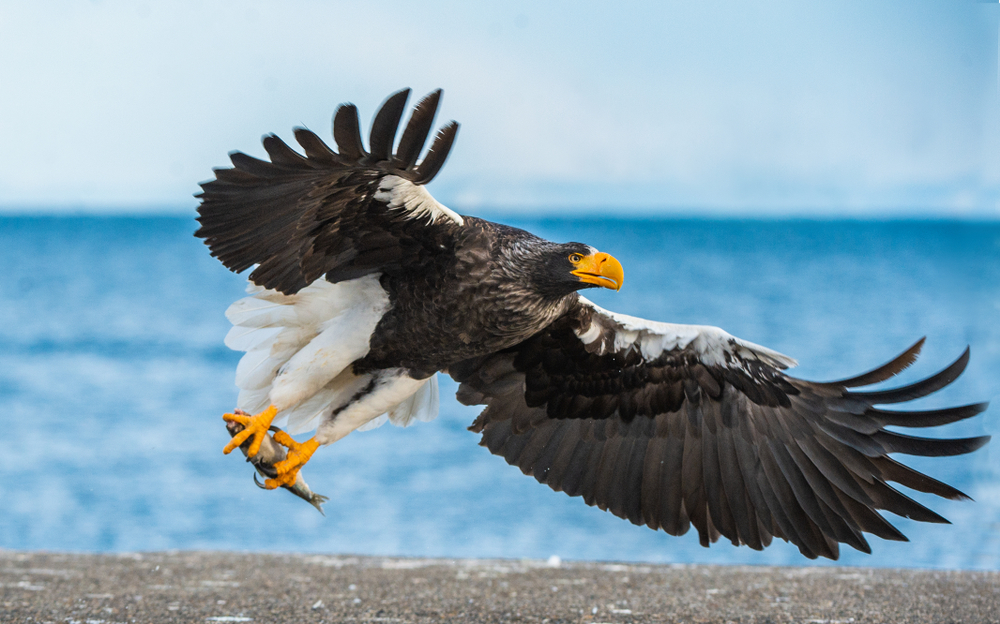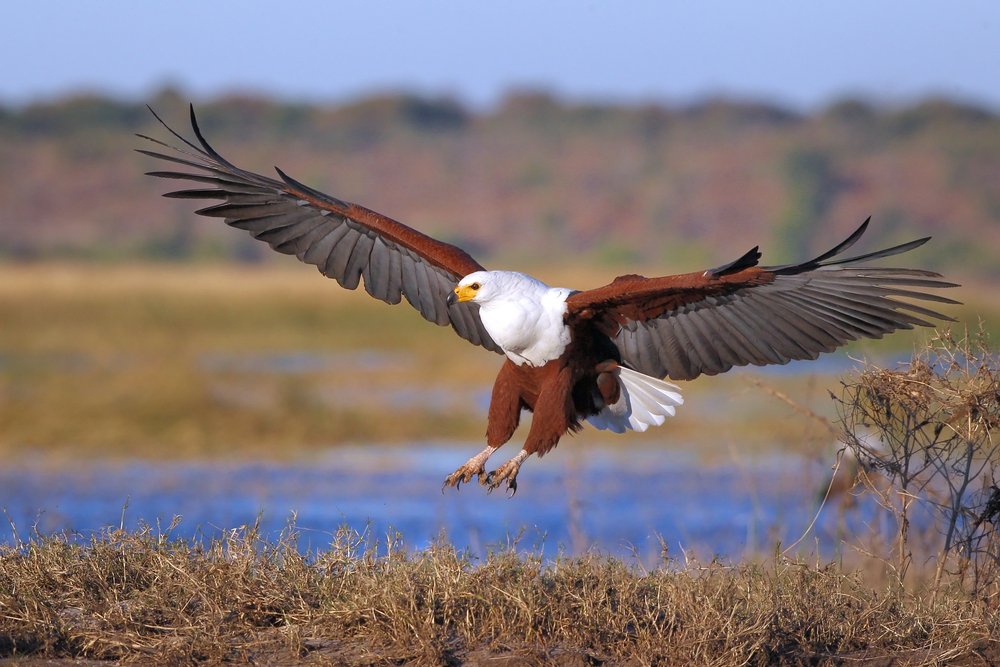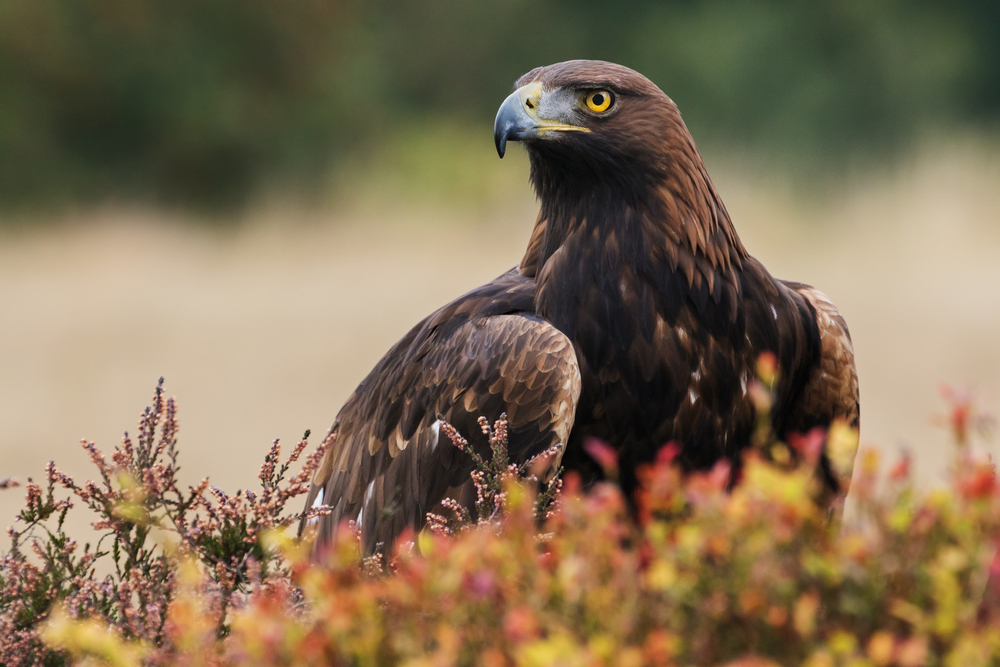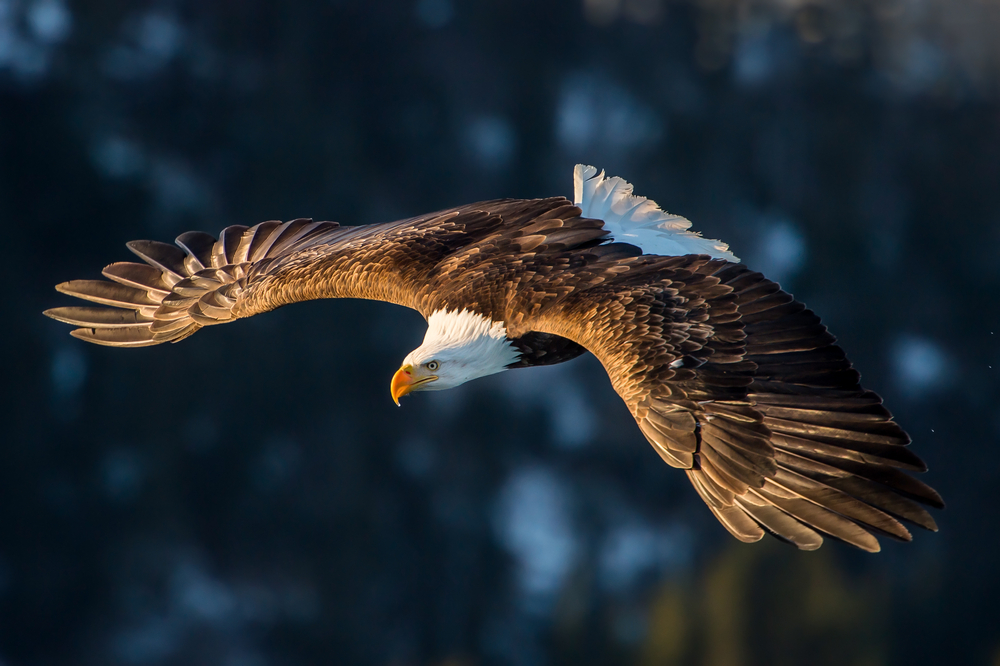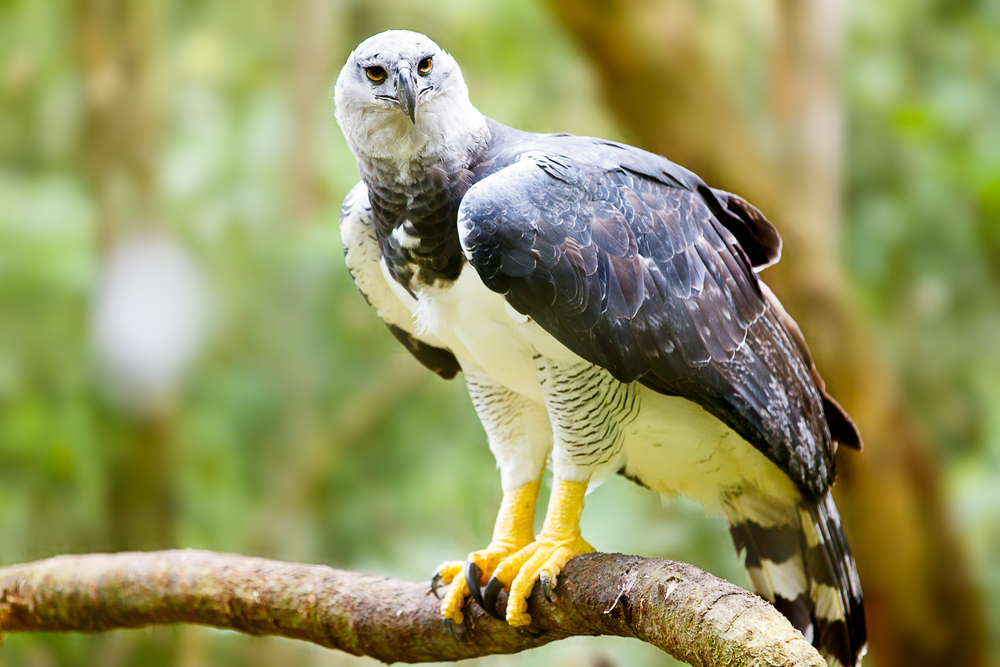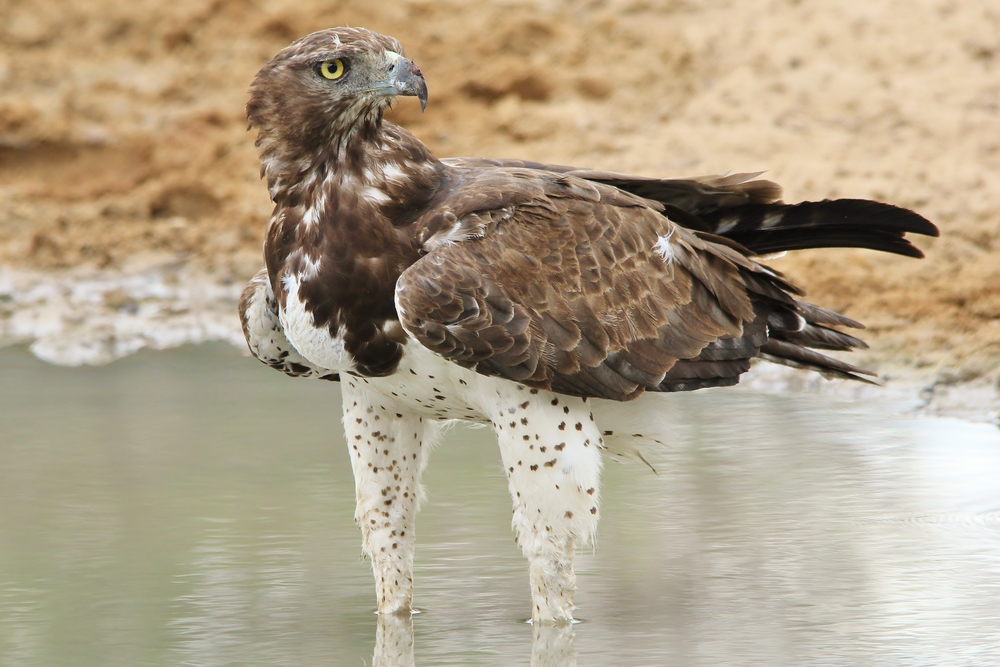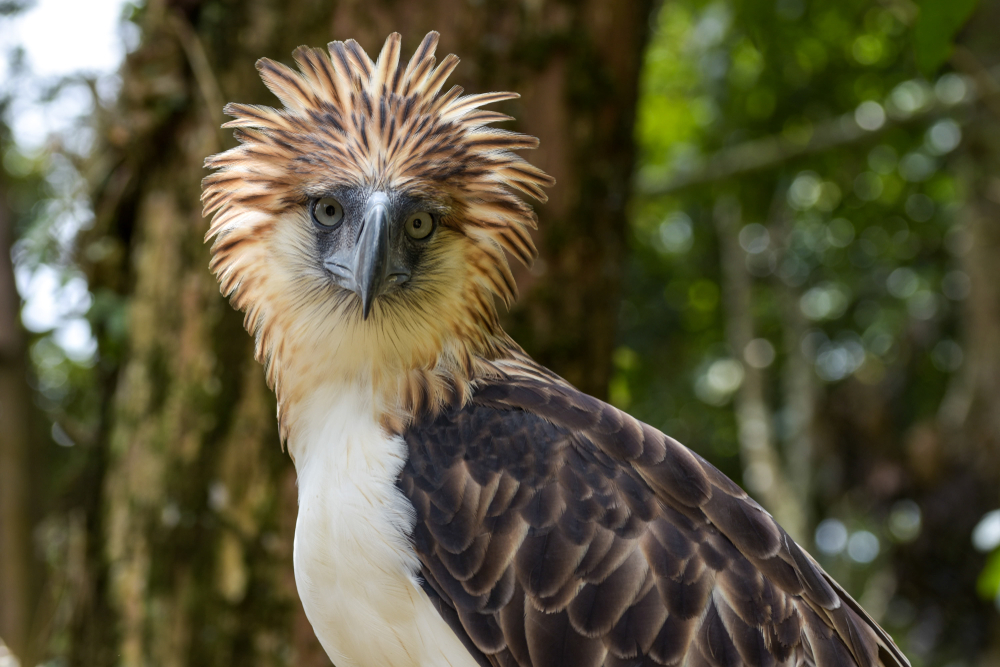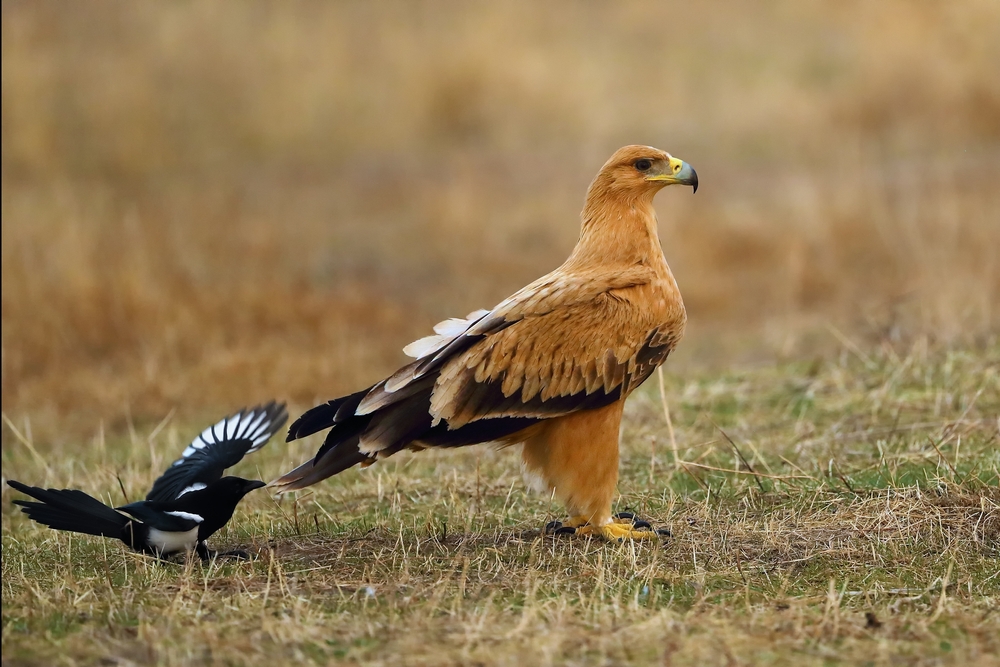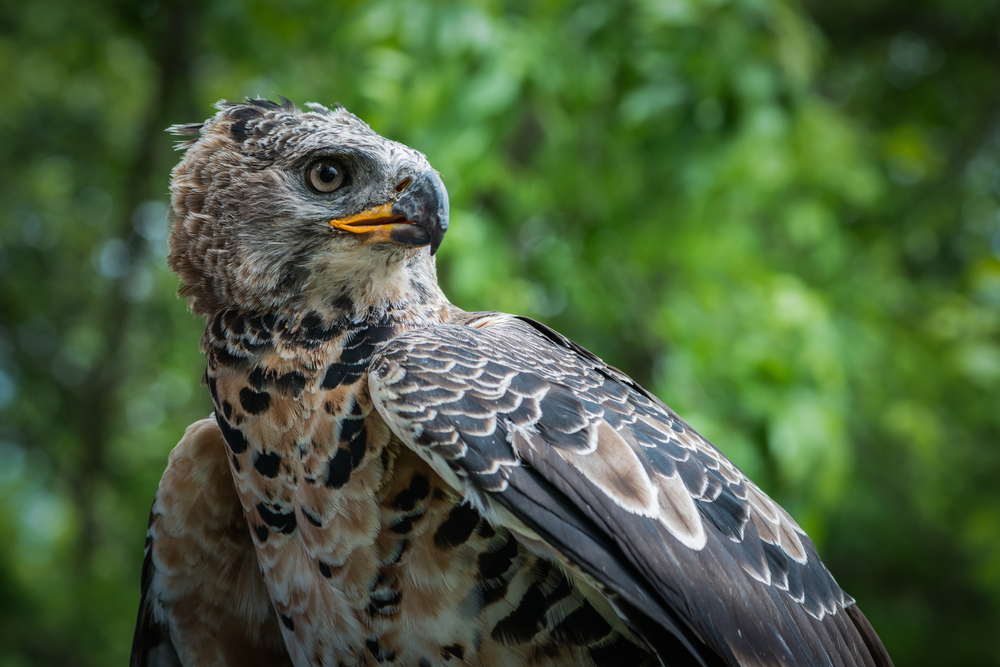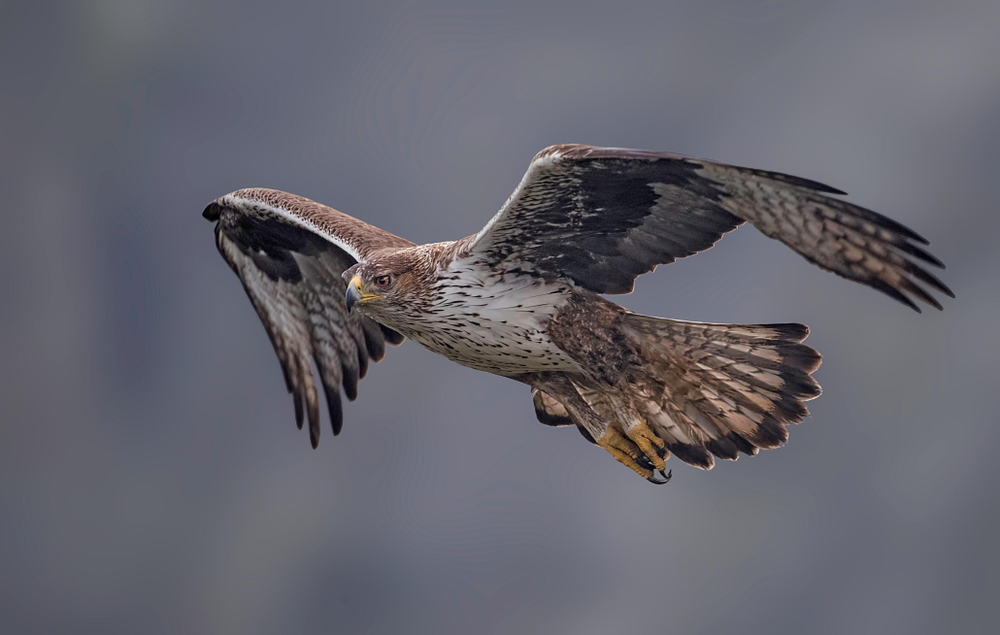The Steller’s Sea Eagle’s closest relative is the Bald Eagle (Haliaeetus leucocephalus) of North America. Both belong to the genus Haliaeetus, the sea eagles, which also includes the White-tailed Eagle (Haliaeetus albicilla).
About
The Steller’s Sea Eagle is one of the largest and most powerful raptors in the world, famed for its massive size, striking appearance, and association with coastal and riverine habitats in northeastern Asia. Found mainly in Russia’s Far East, particularly around the Sea of Okhotsk and the Kamchatka Peninsula, it is also seen in Japan and Korea during winter migrations. With its huge yellow beak, bold white shoulders, and contrasting dark brown plumage, the Steller’s Sea Eagle is instantly recognizable and regarded as one of the most majestic eagles.
This eagle is truly enormous, measuring 85–105 cm (33–41 in) in length, with a wingspan of 195–250 cm (6.4–8.2 ft). Females, larger than males, can weigh up to 9 kg (20 lbs), making the species one of the heaviest eagles on Earth. Its powerful build suits its diet, which relies heavily on fish such as salmon and trout, though it will also hunt waterfowl and scavenge carrion. Often seen perched along shorelines or soaring over rivers, the Steller’s Sea Eagle uses its immense talons and hooked bill to capture and tear apart prey.
Breeding pairs construct massive stick nests, often reused year after year, in tall trees or rocky cliffs near water. Typically, the female lays one or two eggs, with only one chick usually surviving to fledge after about 70 days. The species has a slow reproductive rate, and chicks may remain dependent for months after leaving the nest. In the wild, these eagles may live up to 20–25 years.
The scientific name of the Steller’s Sea Eagle is Haliaeetus pelagicus, and it belongs to the family Accipitridae, which includes other sea eagles such as the Bald Eagle and White-tailed Eagle. Though classified as Vulnerable, with an estimated 4,000 individuals remaining, its population is stable in protected areas. With its immense size and regal bearing, the Steller’s Sea Eagle stands as one of the most awe-inspiring raptors in the world.
Physical Characteristics
The Steller’s Sea Eagle (Haliaeetus pelagicus) is the heaviest eagle in the world, renowned for its massive bill, bold plumage, and dominance along the coasts of northeast Asia.
Plumage:
Adults display a dramatic contrast of dark brown to black body feathers with bright white shoulders, thighs, and tail. The underwing coverts are white, while the flight feathers are dark, creating a striking pattern in flight. Juveniles are uniformly brown with mottled markings, gradually gaining adult coloration by 4 to 5 years of age.
Head and Face:
They have a large head with a massive yellow-orange bill, the largest of any eagle species, strongly hooked and perfectly adapted for tearing through fish and carrion. The eyes are pale yellow, giving them a piercing, commanding gaze.
Body and Wings:
Steller’s Sea Eagles are heavily built, with a stocky, muscular body and broad wings suited for soaring over coastlines and rivers. Their short, wedge-shaped tail and broad wing structure allow stability during powerful flight and hovering over water.
Size:
-
Length (Body): 34 to 41 in (85 to 105 cm)
-
Wingspan: 78 to 98 in (2 to 2.5 m)
-
Tail Length: 12 to 16 in (30 to 40 cm)
Weight:
-
Males: 11 to 15 lbs (5 to 7 kg)
-
Females: 15 to 20 lbs (7 to 9 kg), making them among the heaviest of all raptors.
Bill and Talons:
Their massive yellow bill is their most distinctive feature, while their talons are equally formidable, designed for gripping slippery fish and dispatching prey.
The Steller’s Sea Eagle’s gigantic size, massive bill, and bold black-and-white plumage make it one of the most visually impressive and powerful eagles in the world.
Reproduction
The Steller’s Sea Eagle has a slow breeding cycle, typical of large raptors, with strong pair bonds and extended parental care.
1. Mating and Courtship:
Steller’s Sea Eagles are monogamous, forming long-term pair bonds. Courtship displays include aerial soaring, mutual calling, and bill-touching rituals. Pairs occupy large territories near rivers, coasts, or lakes.
2. Nesting:
Nests are enormous stick structures built high in tall trees or on rocky outcrops. They can measure 6 to 8 feet (1.8 to 2.5 m) across and are reused annually, often enlarging over the years. Pairs may maintain multiple nests within their territory.
3. Egg-Laying:
The female lays 1 to 3 eggs, usually in late March to early April. In most cases, only one chick survives to fledging due to competition or food shortages.
4. Incubation:
Incubation lasts 38 to 45 days, with the female performing most of the incubation while the male provides food.
5. Raising Chicks:
Chicks hatch covered in white down. The female broods them closely for the first few weeks, while the male supplies fish and other prey. Both parents later feed the growing chicks, tearing food into small pieces.
6. Fledging and Independence:
Young fledge at about 10 to 12 weeks, but remain dependent on their parents for food and survival training for several more weeks.
The Steller’s Sea Eagle’s reproductive cycle—small clutch sizes, long incubation, and extended care—ensures the survival of one strong chick per cycle but limits population growth, making the species sensitive to environmental changes.
Lifespan
The Steller’s Sea Eagle is a long-lived raptor, with survival tied to stable coastal and river ecosystems rich in fish.
Lifespan in the Wild:
In natural conditions, Steller’s Sea Eagles typically live 20 to 25 years, with some individuals reaching close to 30 years. Mortality is highest among young eagles in their first few years, as they adapt to hunting and survival challenges.
Lifespan in Captivity:
In zoos and conservation programs, they may live up to 35 to 40 years, thanks to consistent food, veterinary care, and protection from natural and human threats.
Threats to the Steller’s Sea Eagle:
-
Habitat Loss: Logging and human development reduce nesting trees and feeding grounds.
-
Food Scarcity: Declines in salmon and other fish impact breeding success.
-
Pollution: Heavy metals, pesticides, and oil spills contaminate waterways, weakening populations.
-
Climate Change: Shifts in ice cover and fish migration patterns alter feeding opportunities.
-
Persecution & Disturbance: Though legally protected, occasional hunting, poisoning, and nest disturbance remain threats.
Care and Protection:
Conservation efforts in Russia and Japan focus on protecting salmon stocks, securing nesting areas, monitoring pollutants, and preventing illegal hunting.
The Steller’s Sea Eagle’s long lifespan, reliance on fish-rich ecosystems, and slow reproduction make it a powerful but vulnerable symbol of northeast Asia’s coastal wilderness.
Eating Habits
The Steller’s Sea Eagle is a fish-eating specialist, though it also hunts birds and mammals, making it one of the most adaptable coastal raptors.
Diet:
Their primary food source is fish, especially salmon, trout, and other large species found in rivers and coastal waters. They also prey on waterbirds such as ducks and gulls, and occasionally take small mammals like hares and foxes. In winter, they often scavenge carrion, including remains of seals and deer.
Hunting Strategy:
Steller’s Sea Eagles are opportunistic hunters. They patrol rivers and coastlines, swooping down to snatch fish with their massive talons. They are also known to steal prey from other birds, including gulls and smaller eagles.
Killing Technique:
Fish are caught by a swift strike of the talons, while birds and mammals are subdued with their immense bill and crushing grip. Large prey is torn apart with their powerful hooked beak.
Feeding Behavior:
They usually feed near water, carrying smaller fish to perches but consuming larger prey on the spot. During breeding season, parents deliver freshly caught fish to their chicks. In winter, groups may gather around abundant food sources, feeding side by side.
Special Considerations:
-
Fish Specialist: While salmon are preferred, their flexible diet allows survival in changing conditions.
-
Scavenging Role: By feeding on carrion, they help recycle nutrients in coastal ecosystems.
-
Seasonal Diet: Fish dominate in summer, while carrion and waterbirds form a larger portion of the diet in winter.
The Steller’s Sea Eagle’s specialization in salmon, opportunistic hunting, and scavenging habits make it both a skilled predator and an important cleaner of its ecosystem.
Uniqueness
The Steller’s Sea Eagle is one of the most striking and powerful raptors on Earth, celebrated for its size, appearance, and ecological role.
Heaviest Eagle in the World:
With females weighing up to 20 lbs (9 kg), it is the heaviest eagle species, surpassing even the Harpy and Philippine Eagles in bulk.
Massive Bill:
Its enormous yellow-orange bill, the largest of any eagle, is a defining trait, allowing it to rip through fish, carrion, and tough hides with ease.
Bold Plumage:
The Steller’s Sea Eagle’s dramatic black-and-white plumage, highlighted by white shoulders, thighs, and tail, makes it instantly recognizable among raptors.
Coastal Specialist:
Unlike forest-dwelling giants such as the Harpy and Crowned Eagles, the Steller’s Sea Eagle is a coastal and riverine hunter, specializing in salmon and waterbirds.
Cultural Icon:
In Japan and Russia, it is revered as a symbol of power, resilience, and wilderness. It attracts birdwatchers from around the world, especially during its winter gatherings in Hokkaido, Japan.
Conservation Status:
Classified as Vulnerable, with an estimated population of only 5,000 individuals, it faces threats from habitat loss, pollution, and climate change.
The Steller’s Sea Eagle’s immense size, massive bill, coastal specialization, and cultural importance make it one of the most unique and awe-inspiring eagles on the planet
Be the First to Share Photos of This Species.
FAQ’s
1. What is the closest species to the Steller’s Sea Eagle?
2. How does the Steller’s Sea Eagle compare to other eagles?
The Steller’s Sea Eagle is the heaviest eagle in the world, with females reaching up to 20 lbs (9 kg). It is bulkier than the Harpy or Philippine Eagle but has a slightly shorter wingspan than some soaring eagles like the White-tailed or Golden Eagle. Its massive yellow-orange bill and bold black-and-white plumage make it unmistakable.
3. What national parks provide the best chance to see a Steller’s Sea Eagle?
Steller’s Sea Eagles breed along the coasts and rivers of Russia’s Far East, particularly around the Kamchatka Peninsula. In winter, they migrate to Japan, where they are best seen in Shiretoko National Park (Hokkaido) and surrounding coastal reserves. Smaller numbers also appear in the Korean Peninsula and China during migration.



































































